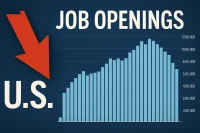Hidden Labor Market Crisis: Government Reports Mask Massive Full-Time Job Losses
The mainstream media continues to paint a rosy picture of the U.S. labor market, but a closer examination of February’s employment data reveals a disturbing reality. While headlines celebrated 151,000 new jobs, the household survey—a separate government report—uncovered a staggering loss of 1.2 million full-time positions. This dramatic disconnect between official narratives and economic reality suggests we’re standing at the precipice of a major economic downturn.
Two Employment Reports, Two Different Stories
The U.S. government produces two monthly employment reports with drastically different methodologies and results:
The Headline Survey
The establishment survey (commonly called the “headline” report) suggested 151,000 new jobs were created in February. This is the figure most media outlets reported, creating an impression of continued economic strength and robust hiring.
The Household Survey
The less publicized household survey revealed a much bleaker picture:
– 1.22 million full-time jobs disappeared
– Long-term unemployment remained at 1.5 million people
– 20.9% of unemployed Americans have been jobless for 27+ weeks
– Part-time employment for economic reasons increased by 460,000 to 4.9 million
This stark contrast between reports isn’t merely a statistical anomaly—it’s a warning sign that has preceded previous recessions.
Historical Patterns: Full-Time Job Losses Precede Recessions
When examining previous economic downturns, a clear pattern emerges: significant full-time job losses often serve as an early indicator of impending recession.
– Dot-com Bubble (2000-2001): Full-time jobs decelerated before contracting late in the recession
– Global Financial Crisis (2007-2009): Job losses accelerated as the recession deepened
– COVID-19 Pandemic (2020): Immediate job losses due to shutdowns
What makes the current situation particularly alarming is the magnitude of the decline—1.2 million full-time jobs lost in a single month represents a more severe contraction than what we witnessed in the early stages of previous recessions.
Economic Policy Institute’s labor market analysis
The Economic Ripple Effect of Full-Time Job Losses
The loss of 1.2 million full-time positions creates a dangerous economic chain reaction that threatens to accelerate into a full-blown recession:
Reduced Consumer Spending
When workers lose full-time employment, their spending power diminishes dramatically. Even those who transition to part-time work experience significant income reduction, forcing them to prioritize essential expenses and eliminate discretionary spending.
Retail Sales Contraction
Historical data shows a clear correlation between rising unemployment claims and declining retail sales:
– Early 2000s: As unemployment claims rose, inflation-adjusted retail sales decelerated and contracted
– 2006-2007: Continued claims bottomed out and began rising, followed by retail sales decline
– Current situation: With 1.22 million Americans losing full-time jobs, retail spending is likely to drop sharply
Manufacturing Slowdown
As consumer spending falls and inventory builds up on retail shelves, manufacturers receive fewer orders:
– Durable goods orders historically decline following retail sales contractions
– Manufacturing hours get cut, leading to more layoffs
– This creates a self-reinforcing cycle of economic contraction
Find Employment Opportunities on WhatJobs
Auto Loan Delinquencies: A Warning Sign of Deeper Problems
One of the most concerning indicators of economic distress is the alarming rise in auto loan delinquencies:
Record-Breaking Delinquency Rates
– Subprime auto borrowers who are at least 60 days past due on loans rose to 6.56% in January—the highest rate since data collection began in 1994
– The share of auto loans among all borrowers that transitioned into serious delinquency (90+ days past due) rose to 3% in Q4 2023—the highest level since 2010
The Subprime Auto Loan Crisis
This situation bears troubling similarities to the subprime housing crisis that triggered the 2008 financial collapse:
– As unemployment rises, more borrowers fall behind on payments
– Delinquencies lead to repossessions and credit restrictions
– Financial institutions holding these loans face mounting losses
– Credit availability tightens across the economy
Consumer Debt Surge: A Desperate Measure
As Americans face job losses and reduced income, many are turning to credit cards and home equity to maintain their standard of living:
Last-Resort Financing
– Consumer debt recently surged by the most on record, exceeding $5 trillion
– Credit card usage is increasing at some of the highest rates in history
– Refinancing activity jumped as homeowners attempt to extract equity
The Credit Crunch Cycle
This pattern creates a dangerous cycle:
1. Job loss leads to reduced income
2. Consumers tap credit cards to cover essential expenses
3. Rising delinquencies cause banks to restrict credit
4. Without access to credit, consumer spending falls further
5. Businesses face declining sales, leading to more layoffs
Hiring?
Post Financial Sector Jobs for Free with WhatJobs
Are you a financial institution navigating these economic challenges? Recruit qualified professionals who understand economic trends and can help your organization weather market volatility.
Post your job openings for free on WhatJobs to connect with talented candidates.
Federal Reserve’s Disconnect from Economic Reality
Despite mounting evidence of labor market deterioration, Federal Reserve officials continue to project confidence in the economy:
Powell’s Perspective
Fed Chair Jerome Powell recently stated:
– “Many indicators show the labor market is solid and broadly in balance”
– The labor market “is not a significant source of inflationary pressure”
– “The economy is fine. It doesn’t need us to do anything really, and so we can wait and we should wait”
The Inflation-Unemployment Relationship
While Powell is correct that rising unemployment typically reduces inflationary pressure, his assessment of labor market strength contradicts the household survey data:
– Previous recessions show continued unemployment claims rising before inflation falls
– 2000-2001: Rising claims led to disinflation
– 2007-2009: Claims preceded deflation
– Current situation: 1.22 million full-time job losses suggest disinflation is coming
Political Response to Economic Challenges
The current administration’s economic strategy faces significant challenges in addressing these labor market issues:
The “No Pain, No Gain” Approach
– Plans for protectionist trade barriers through significant tariff increases
– Proposals to reduce government spending and employment
– Focus on tax cuts and deregulation to stimulate manufacturing employment
Timing Concerns
The critical issue isn’t necessarily the policy direction but rather the timing:
– Private sector job losses are already mounting
– Government spending reductions could accelerate job losses
– The lag between tax cuts/deregulation and job creation could leave millions unemployed
Investment Opportunities Amid Economic Uncertainty
Despite the concerning economic outlook, strategic investors can still find opportunities:
Momentum Trading Strategies
– Hong Kong equities have shown strong performance (up over 10%) while U.S. markets decline
– Momentum signals can identify profitable trades in various market conditions
– Risk management becomes increasingly important during economic transitions
FAQ: Full-Time Job Losses and Economic Impact
What do the recent full-time job losses indicate about the U.S. economy?
The loss of 1.2 million full-time jobs revealed in the household survey suggests the U.S. economy is facing a significant downturn. Full-time job losses of this magnitude have historically preceded recessions, as they trigger a chain reaction of reduced consumer spending, declining retail sales, and manufacturing contractions. Unlike the headline employment figures that showed modest job growth, these full-time job losses represent a more accurate indicator of economic health.
How do full-time job losses affect consumer spending and the broader economy?
Full-time job losses dramatically reduce household purchasing power, forcing consumers to prioritize essential expenses and eliminate discretionary spending. This spending reduction creates a dangerous ripple effect throughout the economy: retailers experience lower sales, leading them to order fewer goods from manufacturers, who then reduce production and lay off more workers. This self-reinforcing cycle of full-time job losses and decreased spending can quickly accelerate economic contraction.
Why are auto loan delinquencies rising despite reports of a strong job market?
Rising auto loan delinquencies—now at their highest level in decades—directly contradict claims of a robust job market and instead align with the household survey showing massive full-time job losses. When workers lose full-time employment or transition to lower-paying part-time work, they struggle to maintain payments on high-interest auto loans. The record-breaking delinquency rates suggest financial distress is spreading among consumers, particularly those with subprime credit who are most vulnerable to full-time job losses.
What actions should individuals take to prepare for potential economic challenges related to full-time job losses?
With 1.2 million full-time job losses already reported and more likely to follow, individuals should take proactive steps to strengthen their financial position. This includes building an emergency fund covering 6-12 months of expenses, reducing high-interest debt while credit is still available, developing marketable skills that remain in demand during downturns, and diversifying income sources beyond traditional employment. Those concerned about full-time job losses should also consider defensive investment strategies that perform well during economic contractions.
How might Federal Reserve policy respond to increasing full-time job losses?
Despite the Federal Reserve’s current reluctance to cut interest rates, the mounting evidence of full-time job losses will likely force a policy shift in the coming months. Historically, when unemployment rises significantly, the Fed responds with monetary easing to stimulate economic activity. However, rate cuts alone may prove insufficient if credit availability tightens due to rising delinquencies. The effectiveness of monetary policy in addressing full-time job losses depends largely on whether unemployed workers can access credit, which becomes increasingly difficult as delinquency rates rise.
This comprehensive analysis of the alarming 1.2 million full-time job losses reveals a troubling disconnect between headline economic figures and the reality facing American workers. As consumer spending weakens, delinquencies rise, and credit conditions tighten, the economy appears poised for a significant contraction. Individuals and businesses alike must prepare for challenging economic conditions while remaining alert to investment opportunities that emerge during market transitions.




